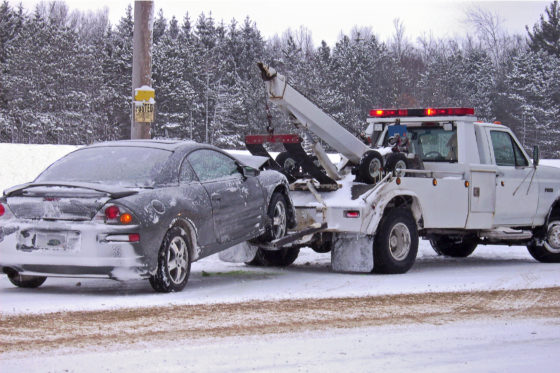Tow truck drivers face unique risks at work. Drivers need to slow down and move over when they see flashing lights on a tow truck or any other vehicle.

Photo credit: iStock.com/liveslow
This is part two of my focus on road safety. Check out last week’s post, Reminding truckers about the hazards of stopping roadside.
B.C.’s annual Cone Zone campaign is in full swing. Its goal is to remind motorists about the safety of people who work on or beside our roads.
Between 2009 and 2018, 13 workers died on the job on B.C.’s roads. Two of them were tow truck operators hit by passing vehicles. Between 2005 and 2019, another 15 tow truck operators had to be off work due to injuries sustained while working on or beside the road.
Tow truck drivers and others in the auto recovery industry play an important role on our roads. We rely on them to provide crucial help for stranded drivers and to keep traffic flowing. Sometimes tow truck drivers assist commercial truck drivers like those in last week’s post. If a truck breaks down in the middle of a highway, it’s a tow truck that has to come and pull it out.
Operators often work in challenging environments
Workers in the towing and recovery industry face unique risks. Tow truck drivers frequently work in challenging environmental conditions that include hazards such as narrow work areas, blind corners, and speeding motorists.
“You’re working 24-7 in all sorts of environmental conditions,” says Ken Hendricks, towing and recovery advisor for B.C.’s Automotive Retailers Association (ARA). “Often, the location of these ‘temporary worksites’ are unplanned so you don’t know what kind of a situation you’re going into.”
For employers and tow truck operators, taking the time to set up a safe work zone is critical, says Jacqueline Morrison, an industry specialist for Transportation and Occupational Road Safety at WorkSafeBC.
“Tow operators feel constant pressure to ‘go, go, go’ but the few minutes it takes to put on a high-visibility vest, run a risk assessment, and set up the controls can help reduce the risk they face on the road,” she says, adding that the ARA provides a free, downloadable safe work practices manual for those in the industry.
Slow down and move over when you see flashing lights
Typically, a single tow truck job takes between 15 and 30 minutes. Tow trucks have flashing amber lights to alert approaching motorists that there is a unique type of emergency response situation ahead.
Under B.C.’s Slow Down, Move Over law, motorists must slow down and move over for all vehicles with flashing lights. (For more information, see my post New laws to protect roadside workers.)
“The simplest thing I want to tell drivers is to adhere to the law and to slow down and move over when they see tow trucks with lights flashing,” says Ken. “If everyone did that, we would be able to save a lot of lives.”
See the ARA website for more information about their efforts to improve safety for workers in B.C.’s towing and recovery industry. Also see WorkSafeBC’s Auto recovery & towing webpage for health and safety resources.


